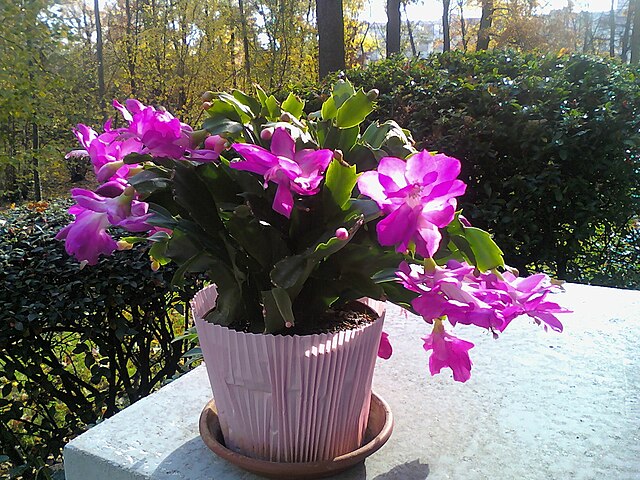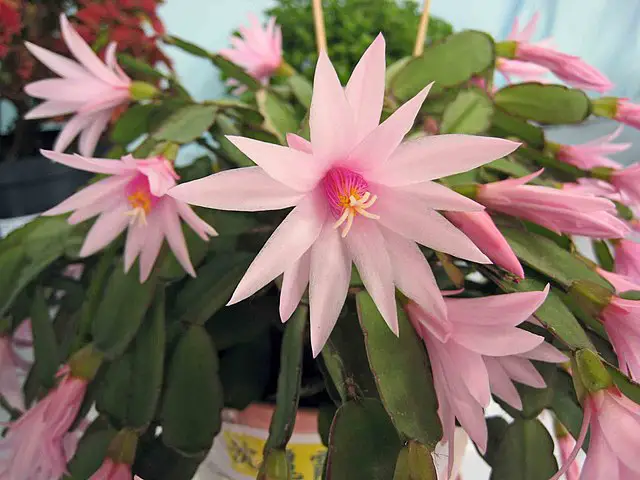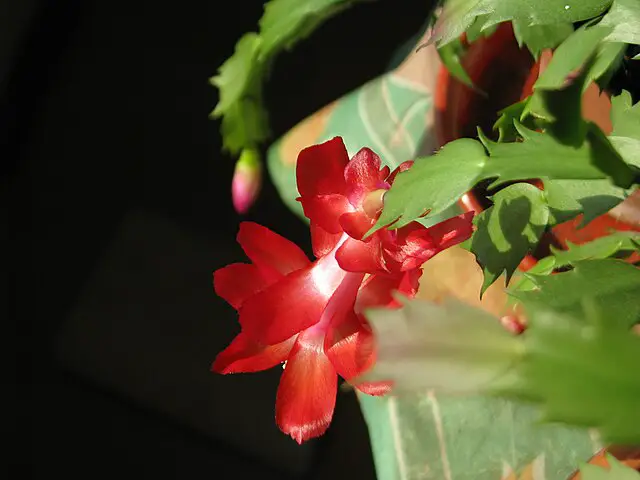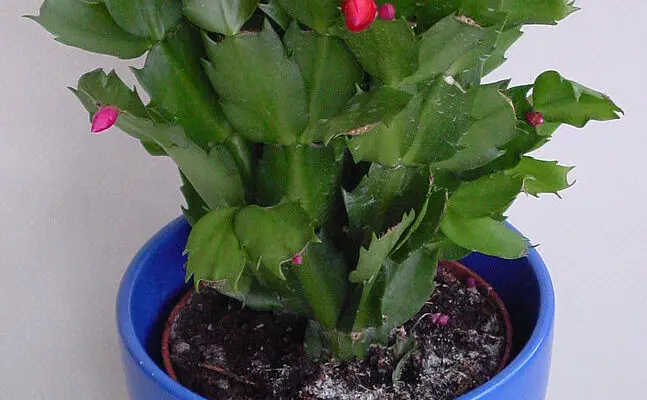The Christmas cactus, scientifically known as Schlumbergera, is a succulent plant that has become synonymous with the festive season. Its vivid, trumpet-shaped blooms in hues of red, pink, purple, orange, and white make it a cherished addition to holiday decor. Unlike its arid cousins, the Christmas cactus thrives in a more tropical climate, originating from the rainforests of Brazil. This article aims to address common questions and provide detailed care instructions for this yuletide favorite.
Varieties of Christmas Cactus
Schlumbergera is a small genus, and within it are several closely related species and hybrids that are commonly grown as houseplants. They are often collectively referred to as ‘holiday cacti’ due to their flowering times.
Schlumbergera bridgesii (True Christmas Cactus)
Also known as the classic Christmas cactus, Schlumbergera bridgesii typically blooms in December. It features rounded leaf margins and pendulous flowers with a symmetrical shape, often in shades of red, pink, or purple.
Schlumbergera truncata (Thanksgiving Cactus)

The Thanksgiving cactus is frequently mistaken for the Christmas cactus due to their similarities in appearance and flowering time. Schlumbergera truncata blooms a bit earlier, generally from late fall around the American Thanksgiving holiday. It can be distinguished by its pointed, claw-like projections on the edges of the stems and upright, asymmetrical flowers.
Schlumbergera × buckleyi (True Christmas Cactus Hybrid)

This hybrid variety is a result of crossing Schlumbergera truncata with the true Christmas cactus. It retains the rounded edges of its parent, Schlumbergera bridgesii, and displays spectacular blooms similar to that of Schlumbergera truncata.
Schlumbergera gaertneri (Easter Cactus)

Though not a true Christmas cactus, the Easter cactus is another member of the Schlumbergera genus that blooms in the spring around Easter. Its leaves have fibrous coats and it flaunts star-shaped, vividly colored flowers.
Christmas Cactus Light Requirements
The Christmas cactus (Schlumbergera) is a tropical, rainforest-originating plant with specific light needs that differ from the full-sun preference of desert cacti. Understanding these requirements is crucial for the health and flowering of the plant.
Christmas cacti enjoy bright conditions but not direct sunlight. They thrive under indirect sunlight or in partially shaded areas that emulate the dappled sunlight of their natural rainforest habitat. Direct exposure, especially during the hot midday sun, can scorch the leaves and damage the plant.
Can Christmas Cactus Take Full Sun?
No, Christmas cacti cannot tolerate full sun for extended periods. While they require good light to bloom, the intense rays of full sunlight can cause sunburn on the foliage, leading to a wilted or discolored appearance.
How Much Light Does Christmas Cactus Need?
Christmas cacti need bright but indirect light for most of the day. A north or east-facing window is ideal as it provides the necessary light without the harsh intensity of direct afternoon sun.
Where to Place Christmas Cactus
The best location for your Christmas cactus is near a window where the light is filtered through a sheer curtain or blinds. Ensuring the plant is not in a position where it will receive direct sunlight will prevent leaf burn and keep the Christmas cactus healthy.
Can Christmas Cactus Stay Outside?
During the warmer months, a Christmas cactus can stay outside as long as it’s not in direct sunlight and temperatures are consistently above 50°F (10°C). It is essential to transition it slowly to avoid shock when moving it from indoors to outdoors or vice versa.
In summary, light is a vital aspect of Christmas cactus care. Protecting the plant from the harsh direct sunlight while ensuring it receives enough indirect light is the key to vibrant blooms and healthy growth. Monitor how your plant reacts to its location and adjust as needed to find the perfect balance of light throughout the year. Since they are sensitive to temperature swings, it’s usually best to bring your Christmas cactus inside well before the threat of cooler temperatures in autumn to prepare it for the winter blooming season.
Can Christmas Cactus Live Outside in Winter?
A Christmas cactus cannot live outside during winter in most climates. This succulent is not cold hardy and should be kept in an environment with temperatures between 60-70°F (15-21°C). Frost or temperatures below 50°F (10°C) can quickly be fatal to this tropical plant.
Christmas Cactus Watering Guide
The Christmas cactus (Schlumbergera) is a tropical plant that prefers a more humid environment compared to desert-dwelling cacti, making proper watering essential to its health and blooming success.
How Often to Water Christmas Cactus
The frequency of watering a Christmas cactus can vary based on several factors including ambient temperature, humidity, light levels, and the plant’s growth cycle. The goal is to keep the soil evenly moist but not waterlogged. Typically, watering once every 2 to 3 weeks is sufficient, but always check the soil first.
Before watering, perform a simple moisture check:
- Touch the top inch of the soil; if it feels dry, it’s time to water.
- If the soil sticks to your finger or feels damp, wait a few more days before checking again.
Signs of Overwatering or Underwatering
Overwatering:
- Soggy or mushy stems.
- Discolored or yellowing leaves.
- Symptoms of root rot such as a foul smell from the soil or a base that is black or brown and mushy.
Underwatering:
- Wrinkled, limp, or shriveled leaves.
- Dry, brittle stems.
- Lack of flower bud development or bud drop.
Watering Technique
When watering your Christmas cactus, use room-temperature water and aim to water evenly around the base of the plant. Allow the water to thoroughly soak the soil until some drains out of the bottom of the pot. Discard any excess water collected in the saucer beneath the pot to avoid letting the plant sit in standing water.
Seasonal Watering Adjustments
Growing Season (Spring to Summer):
During the active growth period, your Christmas cactus will require more frequent watering. Monitor the soil moisture closely, allowing the top inch to dry out before watering again.
Dormant Period (Late Summer to Fall):
As the plant prepares to bloom, reduce watering slightly to encourage flower bud formation. Keep the soil barely moist.
Blooming Period (Winter):
During blooming, you can resume normal watering as blooms can make the plant use more water. However, avoid overwatering as cooler temperatures can slow down water absorption.
Holiday and Post-Holiday Care
After the holidays, when the flowers have faded, it’s a good practice to let the plant rest by watering less frequently until new growth appears in the spring.
Tips for Watering Christmas Cactus
- Use water that is free of chlorine and fluorides, which can accumulate in the soil and harm the plant.
- If the air in your home is very dry, consider setting up a pebble tray with water beneath the plant pot to increase humidity.
- Avoid using cold water as it can shock the roots; tepid or room temperature is best.
In conclusion, watering a Christmas cactus requires a balanced approach that prioritizes soil moisture checking before each watering. Adjusting your watering habits according to the plant’s growth cycle and your home’s environment will help ensure your Christmas cactus remains healthy and produces vibrant, beautiful blooms during the holiday season. Avoid extremes of over and under-watering, and remember that the plant’s needs can change with the seasons.
Christmas Cactus Propagation
The Christmas cactus (Schlumbergera) is not only known for its beautiful winter blooms but also for its ease of propagation. Propagating Christmas cacti allows you to multiply your plants, share them with friends and family, or preserve cherished heirloom specimens. This comprehensive guide will take you step-by-step through the process of propagating Christmas cacti.
Understanding Christmas Cactus Propagation
Propagation is the process of creating new plants from cuttings of an existing plant. For Christmas cacti, propagation is usually done by stem cuttings, which root easily and maintain the characteristics of the parent plant.
When to Propagate Christmas Cactus
The best time to propagate Christmas cacti is in the early summer after the plant has finished blooming and is entering its active growth phase. This allows cuttings to root and grow during the warmer months, establishing a robust root system before the cooler, dormant period.
Tools and Materials
- A healthy Christmas cactus plant
- Clean, sharp scissors or pruning shears
- Potting mix suitable for cacti and succulents
- A small pot with drainage holes
- Rooting hormone (optional)
Propagation Steps:
Step 1: Taking Cuttings
Identify healthy, vibrant segments of the Christmas cactus to use as cuttings. Choose segments that are at least 2-3 segments long for best results. Using clean scissors or shears, make a straight cut between segments, leaving you with a Y-shaped cutting.
Step 2: Curing the Cuttings
Lay the cuttings out on a paper towel or a clean, dry surface, and allow them to cure (callus over) for a few days. This helps prevent rotting when planted and encourages root growth.
Step 3: Preparing the Potting Mix
Fill your small pot with the cactus potting mix, ensuring it’s lightly moistened but not overly wet.
Step 4: Planting the Cuttings
If using rooting hormone, dip the cut end of the segments into the powder, shaking off the excess. Create a small hole in the potting mix with a pencil or finger, and plant the cutting about an inch deep. Gently firm the soil around the cutting for stability.
Step 5: Creating the Right Environment
Place the pot in a warm, bright location out of direct sunlight. Christmas cactus cuttings need bright indirect light and stable temperatures between 65-75°F (18-24°C) to root successfully.
Step 6: Caring for the Cuttings
Keep the soil slightly moist but not saturated. A light watering every few days should be sufficient, depending on the humidity of your home. Do not let the soil dry out completely, as this can hinder root development.
Step 7: Rooting and Repotting
Rooting typically takes between 3-6 weeks. To test for root growth, give the cutting a gentle tug after a month; if you feel resistance, roots have likely formed. Once the cuttings have rooted, you can begin treating them as mature plants, following standard Christmas cactus care routines.
Post-Propagation Care
After propagation, continue to maintain consistent care for your new Christmas cactus. Monitor for pests, provide ample indirect light, water moderately, and start fertilizing once active growth is evident. Be patient, as it can take some time for the new plant to become established and to start flowering.
Frequently Asked Questions
Can You Propagate Christmas Cactus in Water?
Yes, Christmas cactus cuttings can also be propagated in water. Place the cut end into a glass or jar filled with water, ensuring no leaves are submerged. Once roots have developed, you can plant the cutting in soil.
How Do You Encourage Root Growth?
Aside from using rooting hormone, ensuring the cutting is kept in a warm, humid environment with indirect light will help encourage root growth.
Christmas Cactus Soil
When it comes to growing a thriving Christmas cactus (Schlumbergera), the choice of soil is crucial. This succulent, unlike many others in the cactus family, originates from the humid rainforests of Brazil and requires soil that supports both moisture retention and adequate drainage.
The ideal soil for a Christmas cactus should closely mimic the natural growing conditions found in the plant’s native habitat. In the rainforests, these cacti grow in the crevices of tree branches where decomposing organic material provides a rich and well-draining environment.
Components of a Good Christmas Cactus Soil Mix
An effective soil mix for Christmas cacti should contain a balance of the following elements:
Organic Matter
Peat or coir provides moisture retention and a slightly acidic pH that Christmas cacti prefer. It helps mimic the decomposition they would experience in their natural habitat.
Perlite or Vermiculite
These inorganic materials enhance soil aeration and drainage. They prevent compaction of the soil, allowing the roots to breathe and preventing water from pooling around them, which can lead to root rot.
Sand
Coarse sand further improves drainage and ensures that the roots are not sitting in water for prolonged periods.
Specialty Cactus Mix
Many garden centers sell pre-mixed cactus and succulent soils that can be used for Christmas cacti. However, it’s often beneficial to add extra perlite or coarse sand to improve drainage.
Creating Your Own Christmas Cactus Soil Mix
To create a suitable potting mix for your Christmas cactus, consider the following recipe:
- Combine two parts of an all-purpose potting soil or peat moss to ensure moisture retention.
- Mix in one part perlite or vermiculite to keep the soil light and aerated.
- Add one part coarse sand to promote quick draining after watering.
Ensure all components are well-blended for a uniform mixture that will provide the roots with the correct balance of water retention and drainage.
Tips for Soil and Repotting
- Christmas cacti should be repotted every few years to refresh the soil and allow for continued growth. The best time to repot is in the spring after the blooming period.
- Always use a pot with drainage holes to allow excess water to escape easily.
- When repotting, take the opportunity to inspect the roots for any signs of rot or disease and trim as necessary before placing into the new soil.
Signs of Poor Soil Conditions
If your Christmas cactus seems to be struggling, the soil might be the culprit. Signs of poor soil conditions include:
- Stunted growth or lack of flowering.
- Yellowing leaves, which could indicate waterlogged soil and insufficient drainage.
- Root rot or a musty smell emanating from the pot, typically resulting from excessive moisture retention.
Fertilization
Proper fertilization is key to the health and bloom of your Christmas cactus (Schlumbergera). Just like any other houseplant, Christmas cacti require nutrients to grow and thrive.
During the Growing Season
From spring through summer, when your Christmas cactus is experiencing active growth, a balanced water-soluble fertilizer will provide the necessary macro and micronutrients. Use a fertilizer with an even N-P-K ratio (e.g., 10-10-10 or 20-20-20) diluted to half strength to avoid over-fertilizing, which can damage the plant or impede flowering. Application should be done every two weeks.
In the Fall
As the day length shortens and temperatures begin to cool, the Christmas cactus enters its pre-flowering stage, signaling a time to reduce fertilization. Switch to fertilizing once a month to support bud development without overwhelming the plant with excessive growth.
In Winter
Once winter sets in and the Christmas cactus has begun blooming, it’s best to cease fertilizing. During this time, the plant’s growth naturally slows, and additional nutrients are not necessary. Resuming fertilization should be delayed until the blooming period is over and active growth recommences in the spring.
Flowering and Bud Set
To encourage a Christmas cactus to set buds and eventually flower, it is necessary to replicate the natural conditions of its habitat by manipulating light and temperature.

Light Requirements for Bud Formation
Christmas cacti are short-day plants, meaning they require prolonged periods of darkness to initiate blooming. Starting around late September or early October:
- Ensure the plant receives 12-14 hours of complete darkness each night.
- Place the cactus in a dark room or cover it with a box or dark cloth to achieve uninterrupted darkness.
- During the day, move the plant to a location where it can receive indirect but bright light.
Temperature Considerations
Alongside the appropriate light conditions, Christmas cacti also respond well to specific temperature ranges, which aid in the initiation of their bloom cycle:
- Maintain night temperatures between 50-55°F (10-13°C), which naturally occurs during fall.
- Avoid placing the plant near heating vents, doors, or other sources of hot air or drafts, as temperature fluctuations can hinder bud set.
Following these guidelines for about six weeks should result in a Christmas cactus setting buds and preparing to flower around the holiday season.
Pests
Despite their hardy nature, Christmas cacti are not immune to pest infestations. Common pests include aphids, spider mites, and fungus gnats, which can hinder the plant’s health and vitality.
Aphids and Spider Mites
These tiny insects suck the sap from the foliage, causing damage and potentially spreading diseases.
- Use a magnifying glass to inspect your plant regularly for these pests.
- At the first sign of infestation, isolate the plant to prevent the spread to other houseplants.
- Rinse the foliage with water to remove some of the pests.
- Apply neem oil or insecticidal soap to infested areas, carefully following the product instructions.
Fungus Gnats
These small flying insects are attracted to moist soil and can infest your Christmas cactus if overwatered.
- Allow the soil to dry out more between waterings to create an environment less hospitable to gnat larvae.
- Use yellow sticky traps to capture adult gnats and reduce the population.
- In severe cases, apply Bacillus thuringiensis subsp. israelensis (Bti) or beneficial nematodes to the soil to target the larvae.
FAQs
Christmas Cactus Indoor or Outdoor?
It’s best grown indoors, or outdoors only in temperate climates during the warmer months.
Is Christmas Cactus Toxic to Pets?
Christmas cactus is non-toxic to cats and dogs, making it a safe choice for pet owners.
Christmas Cactus vs. Thanksgiving Cactus?
The key difference lies in their blooming period and the shape of their leaves. Christmas cacti have rounded edges, while Thanksgiving cacti have pointed edges.
Should I Add Coffee Grounds or Sugar Water to My Christmas Cactus?
While some gardeners report success with coffee grounds for acidity or sugary water for a quick energy boost, these are not standard care practices. If you try them, do so with caution and in moderation.
Conclusion
The Christmas cactus is a delightful plant that, when properly cared for, can become a long-lived part of your plant collection, bringing joy with its annual flowering ritual. By following the comprehensive guidelines provided, you’ll be equipped to cultivate this festive houseplant successfully. Remember to purchase plants from reputable sources and always consider the specific needs of your environment to ensure a thriving Christmas cactus.



